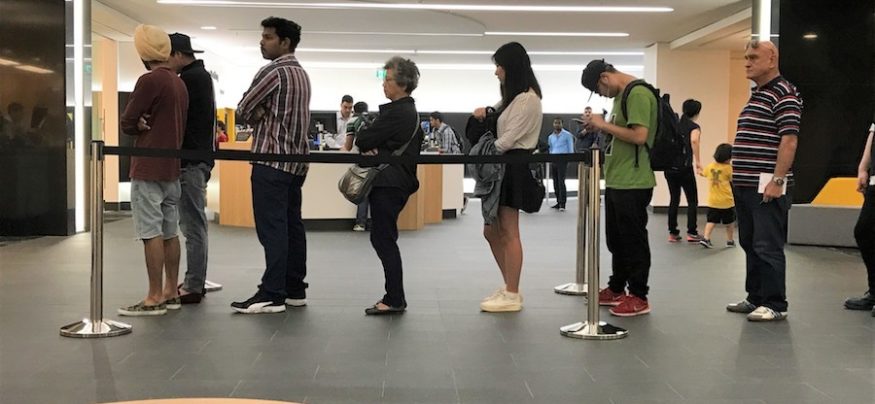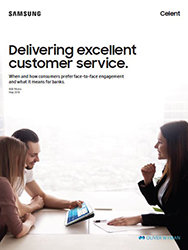You’ve heard the saying, “Perception is reality.” In the case of branch banking, that’s become a bitterly ironic truth.
Because the more convinced banks become that the branch is an outdated channel, the more outdated they’re letting their branches get.
To see where banks are focusing their banking technology dollars and efforts, you’d think retail banking was going to be mobile-only. But a Celent research report shows that not only do customers want branches to remain a key banking channel, they expect them to evolve to keep up with modern capabilities and trends.
So where’s the gap?
Today’s Branch Experience May Be Losing Customers
Since 2010, banking technology priorities have shifted from physical to digital channels, to the point that bank leaders report mobile banking is their highest priority today by a large margin. And it’s not that this shift was a mistake: More customers are using mobile banking, and enabling self-serve transactions increases the frequency with which customers interact with your bank. It was something banks undeniably needed to do.
But now that mobile has found its legs, it’s time for banks to slide some of their focus back to their branches, which are becoming rapidly outdated compared to other consumer retail experiences.
For example, how modern does this sound?
-
Barely more than one-third of banks have deployed automated account opening systems in their branch, and only 17 percent have automated loan origination systems in place. Most are instead using dated, paper-based systems that are not tied to digital channel origination systems. This means simple tasks take much longer than necessary, which both creates a poor customer experience and misuses frontline staff.
-
Fewer than one in five banks offers digital appointment booking, all but guaranteeing customers and prospects alike will have a hit-or-miss experience when visiting a branch for a substantive conversation. The person qualified to address their needs will often be busy with another customer or may not be in the branch at all. Moreover, banks have no visibility into this problem because they don’t currently have any way to gauge average customer wait times.
-
Only 13 percent of banks offer tablet-based applications for their frontline staff, relying instead on desktops set up on counters or inside offices. So a customer’s quick question can turn into a belabored office visit in a flash.
Doesn’t exactly sound like modern banking, does it?
It gets worse when you learn that, other than high fees, a poor branch channel experience is the top reason customers will end their relationship with your bank. What makes a poor branch experience? Ill-equipped banking associates, long waits and a lack of personalization were all identified. Sound familiar? We’ve created our own customer retention nightmare.
Modern Branches Need Modern Banking Technology
Celent chalks up the lack of progress in branch banking technology to the fact that banks see consumers’ digital habits as a sign they aren’t interested in face-to-face banking. But it’s a misleading argument: Yes, the average customer may conduct many more transactions online than in person, but that’s partly because the convenience of online banking is enabling them to conduct transactions more frequently than ever before.
Creating Personalized Customer Experiences
Get your free guide to when, how and why consumers want face-to-face interaction with their banks. Download Now
Also, that channel preference only relates to transactions. When it comes to substantive engagement and the initiation of new accounts, Celent found that banking customers and prospects widely prefer in-person interaction. Only 6 percent of adults prefer fully digital interactions, while 55 percent prefer in-person interactions with their bank. Even 93 percent of millennials like some matters to be handled in-person.
The question is then not whether to put budget and strategy behind updating your branch technology but what to focus on first.
How to Enable Mobile-First Banking
Celent showed that the answer may be complicated and may take some testing with your customer base to get right. But they offered a few suggestions that rated well with consumers:
-
Greet customers by name when they visit the branch. Equipping your branches with Wi-Fi and mobile devices means you can also implement technology that recognizes customers’ mobile devices when they approach the branch.
-
Enable mobile check-in at the branch. Fifty-five percent of customers like the idea of using their mobile apps to announce their arrival, see how long wait times are and compare wait times at other branches.
-
Let customers set branch appointments digitally. Most customers say they would also like the ability to set appointments with branch staff using your mobile app, desktop interface or ATMs. That way, they won’t have to wait as long once they arrive at the branch.
-
Help customers get answers while they wait. It’s a helpless feeling just waiting to be served, which is why more than half of customers say they’d welcome interactive touchscreens that enable them to explore products and get advice while they wait.
Those are just a few relatively simple places to start, but the possibilities for the mobile-first bank are exciting and bountiful. So do some research, get creative and get serious about modernizing your branch banking technology. Because mobile banking may be vital, but customers are still won and lost at the branch.
To learn more, please attend my Oct. 14 Gartner Symposium presentation, “Transforming the Banking Workplace and the Mobile First Customer Experience”. And check out this post about five must-see Gartner sessions.









